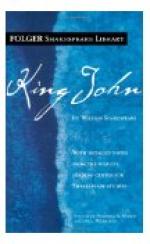|
This section contains 810 words (approx. 3 pages at 300 words per page) |

|
SOURCE: Hunt, Maurice. “Antimetabolic King John.” Style 34, no. 3 (fall 2000): 380-401.
In the following essay, Hunt analyzes Shakespeare's use of antimetabolic tropes in King John, contending that this type of language obscures what is presented as truth and emphasizes the play's theme of indeterminancy.
Lawrence Danson, among others, has demonstrated that certain rhetorical tropes as Elizabethans understood them characterize and order some Shakespeare plays. The action of Coriolanus, for example, amounts to a kinetic combination of two tropes—metonymy and synecdoche (142-62). To these tropes might be added hyperbole in Cymbeline, the “Ouer reacher” (or “lowd lyar”) according to the sixteenth-century English literary critic George Puttenham (191-93). Repeatedly, Posthumus Leonatus, Imogen, lachimo, and other characters of this romantic tragicomedy apply the prefixes of “out” and “o'er” to many words to convey straining ideas of unparalleled beauty, virtue, courtesy, or betrayal and degradation. Hyperbole so created registers what might be...
|
This section contains 810 words (approx. 3 pages at 300 words per page) |

|


